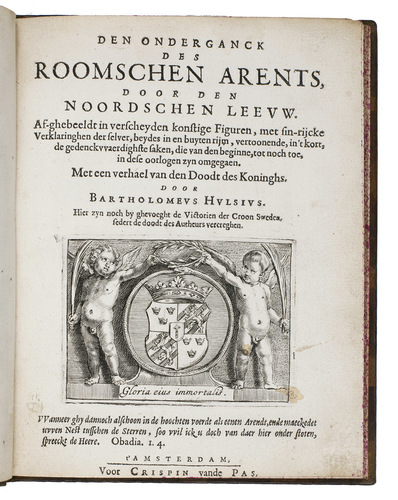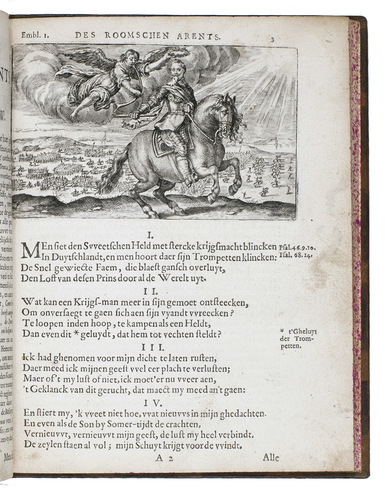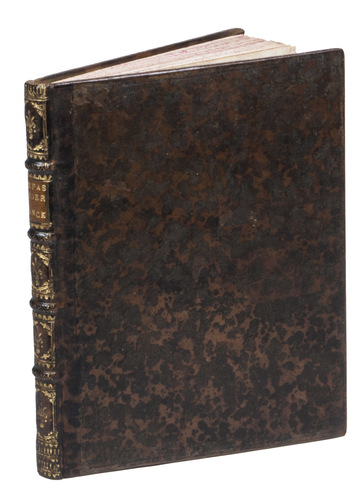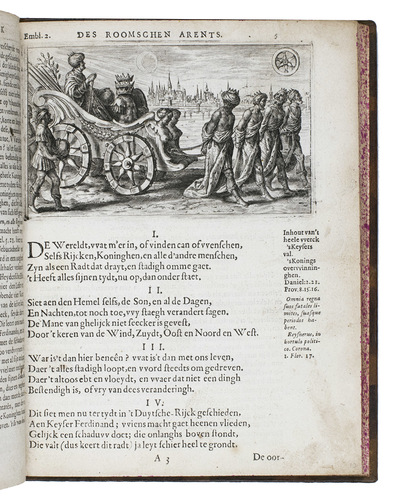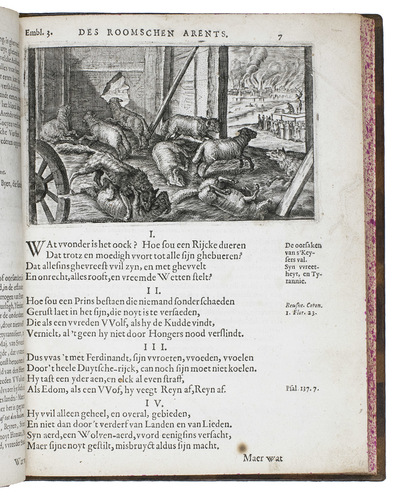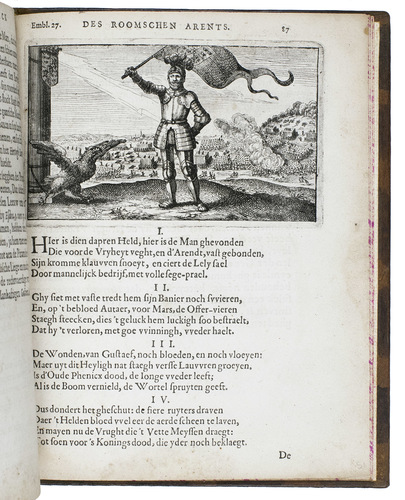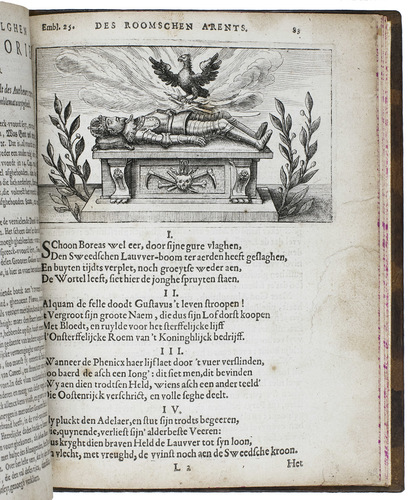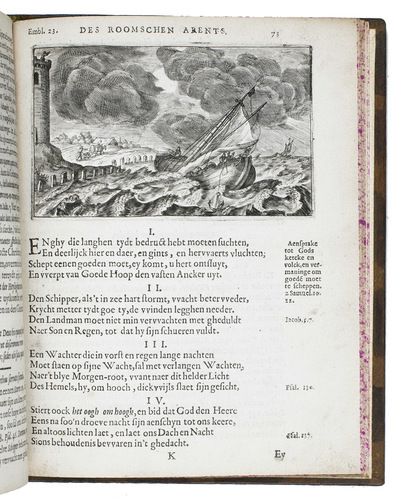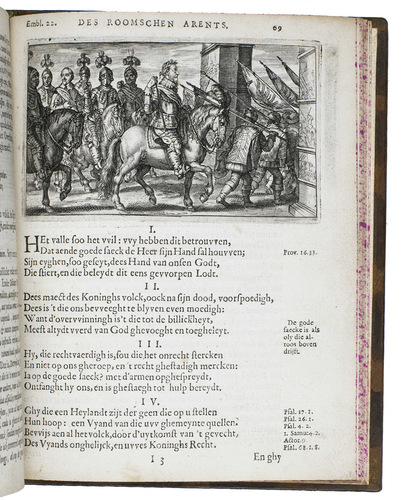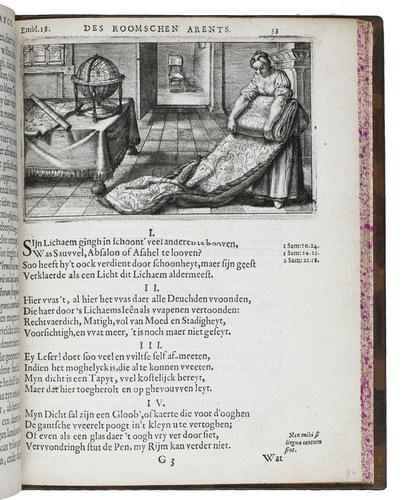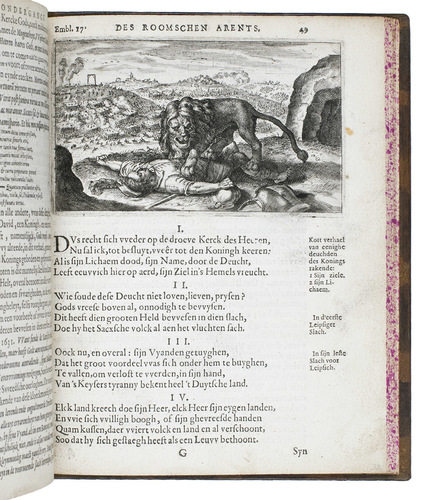HULSIUS, Bartholomaeus.
Den onderganck des Roomschen Arents, door den Noordschen Leeuw. Af-ghebeeldt in verscheyden konstige figuren, met sin-rijcke verklaringhen der selver, beydes in en buyten rijm, vertoonende, in 't kort, de gedenckwaerdighste saken, die van den beginne, tot noch toe, in dese oorlogen zyn omgegaen. Met een verhael van den doodt des Koninghs. Hier zyn noch by ghevoeght de victorien der Croon Sweden, sedert de doodt des auteurs vercreghen.
Amsterdam, Crispijn vande Passe, 1642. 4to. Engraved allegorical title-page with engraved title in a central panel below Fame sitting on a swan. Beautifully bound in 19thcentury light brown gold-tooled calf (1850s or 1860s?), each board with triple along the edges, decorated spine with red and green labels lettered in gold, gold-tooled board edges and turn-ins , marbled endpapers, signed "PETIT SUCCr DE SIMIER": Charles Petit operated a Paris bindery from 1848 to 1873 as successor to René Simier (1772-1843), relieur du roi from 1815, and his son. [12], 91, [1 blank] pp. plus engraved title-page.
€ 15,000
Rare first and only edition of a political and emblematic/allegorical work with texts by Bartholomaeus Hulsius (1601-ca. 1636?), a Reformed minister in Cillaarshoek until his retirement in 1635 (NNBW VIII, col. 889). The book was printed for Crispijn vande Passe by an unknown printer, possibly Jan van Hilten, who specialized in political pamphlets.
The book deals with the struggle between the Protestant parts of Europe and the Catholic Imperial armies (the so-called "League") under the command of the Habsburg emperor Ferdinand II, and the generals Tilly and Wallenstein, known as the Thirty Year's War, which was to continue until 1648. The arrival of the Swedish King Gustav Adolf II the Great (1594-1632) - one of the greatest generals of all times - in Northern Germany in 1630 brought several Protestant triumphs over the Catholics, most famously his victory in the battle of Breitenfeld in 1631.
The beautiful plates are by Crispijn vande Passe the younger (Köln 1594-1670), who worked in Amsterdam from 1640. The last five are etchings, which Franken believed were not by Crispijn vande Passe. Veldman, however, disagrees and attributes them to him in view of their high quality.
Ultimately Gustav Adolph secured the survival of Protestantism in Europe, and the "Bohemian court" in The Hague undoubtedly welcomed him warmly. It included Samuel Hartlib, Comenius, the English ambassador Sir William Boswell and Sir Thomas Roe, ambassador to Gustav Adolph for whom Frederick and Elizabeth were symbol of the Protestant Elizabethan tradition in monarchy. Gustav Adolph was, of course, a hero in these circles and Helsiuss text should be seen in this context.
From the library of Mme Pouilier-Ketele (Auction 1924, lot 192),with a 19th-century annotation on p. 90. With a tear repaired in the margin of G4, but otherwise in fine condition and beautifully bound. Franken, 1373; De Vries 177; Knuttel 4872; Landwehr, Low Countries 360; Landwehr, Emblem books 248; Hollstein XVI, p. 146; Simon McKeown, A Reformed and Godly leader: Bartholomaeus Hulsius's typological emblems in praise of Gustavus Adolphus, in: Reformation, 5 (2000), pp. 55-101; STCN (4 complete copies); Veldman, Crispijn de Passe, pp. 334-337; WorldCat (4 copies, including 1 in STCN); for the bindery: bibliophilie.blogspot.com/2010/05.
Related Subjects:











